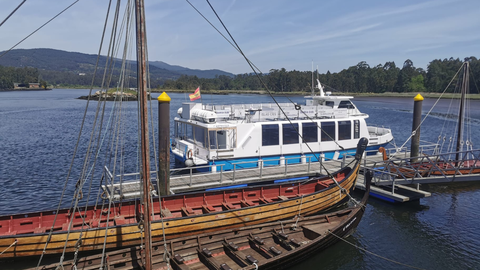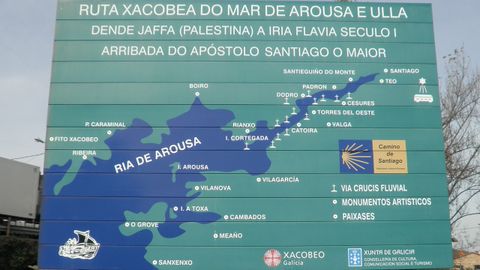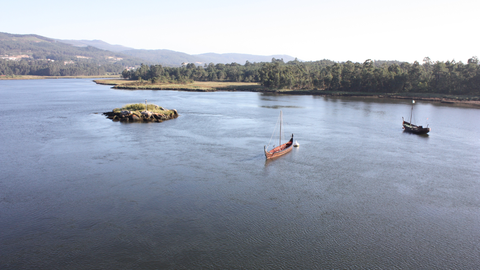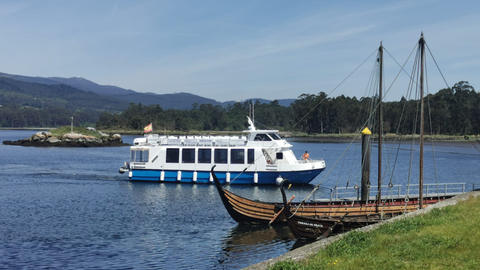The world's only maritime-river Way of the Cross, otherwise known as the Traslatio
VEN A GALICIA










The Camino de Santiago (Way of St. James) by sea runs between 17 cruceiros (stone crosses), located in the Ría de Arousa estuary and along the banks of the River Ulla, marking the route taken by the boat that took the remains of St. James the Apostle to his final resting place
22 may 2023 . Actualizado a las 18:02 h.The most experienced pilgrims not only walk it, they sail it! They traverse the Ruta do Mar de Arousa e río Ulla route, sometimes known as the Traslatio, crossing the island of Cortegada and then sailing past mussel rafts, the West Towers at Catoira and 17 stone crosses that mark out the only maritime-river Way of the Cross in the world, before finally disembarking at the port of Pontecesures, to resume their pilgrimage, now on foot, along the Portuguese Way. A memorable journey that becomes one of those life-defining moments you can relive when you get back home.
This waterbound route is still relatively unknown and therefore great for those looking to avoid the crowds. As its name indicates, it commemorates the route taken by the mortal remains of James the Great in a boat from Jaffa, in Palestine, to Iria Flavia, in the current town of Padrón, way back in the first century. This particular pilgrimage can start in either O Grove or Ribeira, which are the two ports located at the mouth of the estuary, though most pilgrims come from the Spiritual Variant of the Portuguese Way, passing on foot through the monasteries of Poio and Armenteira on the way to Vilanova de Arousa. Once there, there are various tourist boats that can make the 16 nautical mile crossing to Pontecesures in about an hour and a half. “We run regular crossings every day from the beginning of April until 10th November, even if we only have one pilgrim on board. During the rest of the year, we work on a bookings basis and only run if we can get enough heads on board”, explains Santiago Domínguez, skipper and guide of La Barca del Peregrino, who goes on to explain that most of his passengers are Spanish or Portuguese, although he has also met pilgrims from the most remote corners of the world.

The 17 stone crosses that adorn this route follow traditional lines and are anchored to outcroppings along the Ría de Arousa estuary, while also being found along both banks of the River Ulla. Twelve of them are at the water’s edge, while five can be found in and around the ports. The first two are located on the Malveira Grande islet and on the northern tip of the island of Cortegada, which are part of the Atlantic Islands National Park and lead to the mouth of the River Ulla. In front of Punta Patiño, in the municipality of Rianxo, you can see a Calvary —a collection of three crosses— making it one of the most stunning sights on this Way of the Cross.
Heading up the river towards Catoira, pilgrims can see the spectacular West Towers, which witnessed the Norman and Saracen invasions a thousand years ago, and the anchored drakkars, awaiting the Viking Festival, which takes place on the first Sunday of August. Up on deck, one can make out the Brañas de Laíño, a protected wetland in Dodro, and the river beach of Vilarello, in Valga. The final stop is the port of Pontecesures, where pilgrims must walk to Padrón and there resume the Portuguese Way, passing through Picaraña, Faramello and Ames on to Santiago de Compostela. It’s about 15 miles, which can be walked in a single day.

This maritime route was founded by José Luis Sánchez-Agustino, following its presentation at the Provincial Tourism Assembly of A Toxa in 1963, and declared of cultural interest by the Xunta (regional government of Galicia) in 1999. At present, 18 municipalities are members of the board of trustees of the Ruta Xacobea do Mar de Arousa e Ulla Foundation, which even provides a sailor’s handbook to be stamped at the ports.
Literary route
The foundation also promotes a literary route along the shores and river banks of this territory, which has a rich heritage of poets and novelists, including the likes of Camilo José Cela, Rosalía de Castro, Ramón María del Valle-Inclán and Alfonso D. Rodríguez Castelao. The Camilo José Cela Foundation is based in Iria Flavia, in Padrón. In 1990, Cela himself donated his literary and artistic legacy in a bid to preserve his life’s work and make it as widely known as possible. While in Padrón, travellers can also visit the former home and now museum of Rosalía de Castro. Known as the Casa da Matanza, it is where the writer lived with her husband and children and where she would eventually die in 1837. The area surrounding the house used to be an orchard but has since been redesigned to recreate a garden from the period. In Vilanova de Arousa we can find a museum devoted to Ramón María del Valle Inclán and housing numerous bibliographic and documentary collections. In the same estuary, in Rianxo, pilgrims can visit Castelao’s home, which was bought by his father after returning to Galicia following a lengthy spell in Argentina. On the very same street we can also find the houses of the writers Manuel Antonio and Rafael Dieste.
Viking Route
The Ruta Xacobea do Mar de Arousa e río Ulla route, or Traslatio, largely follows the route that the Vikings took during their raids to plunder Iria Flavia and Compostela. As it happens, the mayor of this historic town, Alberto García, who has just announced news in A Coruña of the upcoming Romaría Vikinga 2023 Viking Festival —an event declared of international tourist interest— remarked that “My aim is to promote this route that was followed by both the Saracens and the Vikings, and also used to transfer the remains of James the Great, because it is still one of the lesser known routes. You can sail to Padrón and take in the sights and scenery on both sides of the Ulla and then walk to Santiago.” In Catoira, pilgrims can head to the Torres del Oeste visitor centre and then visit the Ruta Xacobea viewpoint, from where they can clearly see the mouth of the Ulla as it reaches the Ría de Arousa estuary and the only maritime Way of the Cross in the world. One of the less well-known Ways of St. James, yet still very much a Jacobean, literary and Viking route to behold.